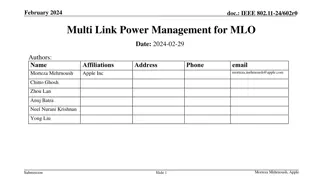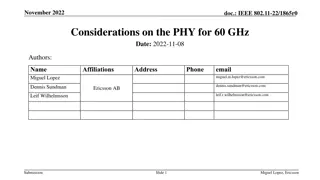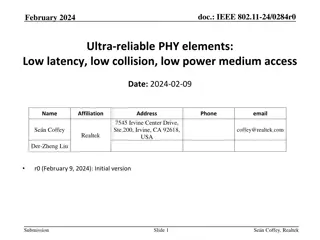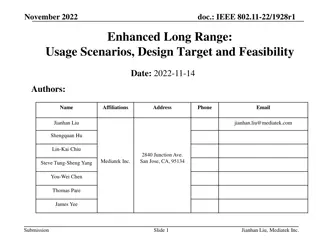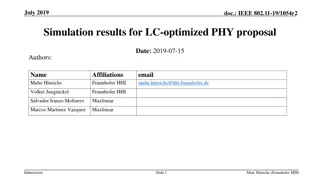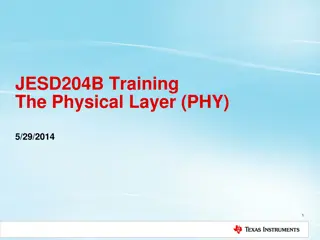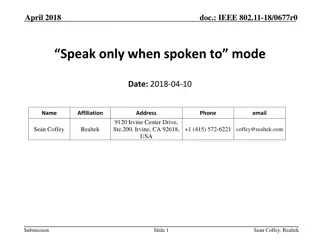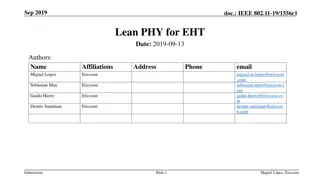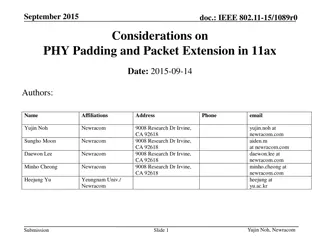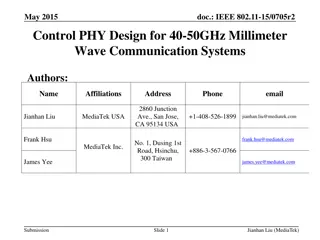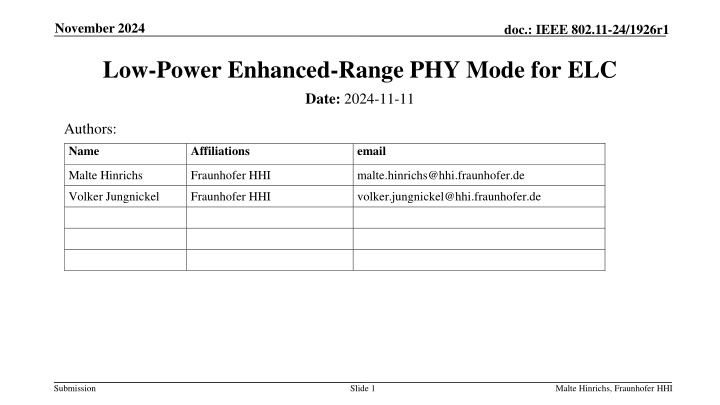
Enhancing Low Power Range with IEEE 802.11-24/1926r1
Introducing On-Off-Keying (OOK) with Frequency-Domain Equalization to boost range and reduce power for ELC in IEEE 802.11-24/1926r1. Addressing limitations in LC's range and power sensitivity, emphasizing the need for wider beams in industrial scenarios. Exploring the benefits of OOK in simplifying LED driver circuits and highpass filtering in LC optical frontend.
Download Presentation

Please find below an Image/Link to download the presentation.
The content on the website is provided AS IS for your information and personal use only. It may not be sold, licensed, or shared on other websites without obtaining consent from the author. If you encounter any issues during the download, it is possible that the publisher has removed the file from their server.
You are allowed to download the files provided on this website for personal or commercial use, subject to the condition that they are used lawfully. All files are the property of their respective owners.
The content on the website is provided AS IS for your information and personal use only. It may not be sold, licensed, or shared on other websites without obtaining consent from the author.
E N D
Presentation Transcript
November 2024 doc.: IEEE 802.11-24/1926r1 Low-Power Enhanced-Range PHY Mode for ELC Date: 2024-11-11 Authors: Name Affiliations email Malte Hinrichs Fraunhofer HHI malte.hinrichs@hhi.fraunhofer.de Volker Jungnickel Fraunhofer HHI volker.jungnickel@hhi.fraunhofer.de Submission Slide 1 Malte Hinrichs, Fraunhofer HHI
November 2024 doc.: IEEE 802.11-24/1926r1 Abstract This contribution introduces On-Off-Keying (OOK) with Frequency-Domain Equalization (FDE) to reduce power and enhance range for ELC. It can be realized with minor changes of the LC PHY. Submission Slide 2 Malte Hinrichs, Fraunhofer HHI
November 2024 doc.: IEEE 802.11-24/1926r1 Motivation LC has limited range ??? ??? ??for optical power ?? ??for electrical power ???~ ??? ??.~??? ??? Low sensitivity due to intensity modulation and direct detection (IM/DD) limited range high power optical TX available smaller cells higher area capacity Implications larger number of APs to provide mobility denser distribution system to cover a service area Submission Slide 3 Malte Hinrichs, Fraunhofer HHI
November 2024 doc.: IEEE 802.11-24/1926r1 Higher Reliability Industrial scenarios need wider beams Overcome blockages by multiple optical APs overlapping coverage is useful, i.e., if one link fails there is another one this concept needs wider beams Correspondingly reduced RX power many use cases ask for better power efficiency and longer range for LC overcome limitations due to the DC-biased OFDM waveform in LC PHY [1, 2] Submission Slide 4 Malte Hinrichs, Fraunhofer HHI
November 2024 doc.: IEEE 802.11-24/1926r1 On-Off Keying (OOK) Simplified LED driver circuit [3-6] LC IF signals typically need 50 LED has only few use FET to match impedances DC-biased OFDM vs. OOK OFDM needs bias (blind power) and reduces modulated light amplitude ( 0.3x) to avoid clipping OOK switches the light on/off zero bias and higher modulated light amplitude w/o clipping OOK is promising to reduce power and increase range Submission Slide 5 Malte Hinrichs, Fraunhofer HHI
November 2024 doc.: IEEE 802.11-24/1926r1 Highpass Filtering 11bb model for LC optical frontend (OFE) combination of high-pass (for bias) and low-pass (LED/PD) [7] Power spectral density of OOK PRBS includes DC components, line codes try to reduce them high-pass in the LC OFE removes low frequency components Statistical effects long runs of consecutive ones and zeros are forced to zero classical line codes instead of PRBS avoid such long runs PRBS Submission Slide 6 Malte Hinrichs, Fraunhofer HHI
November 2024 doc.: IEEE 802.11-24/1926r1 Baseline Wander Baseline Wander Effect random walk depending on the run length in data sequence [8] BLW is stronger for 64B66B 8B10B can reduce BLW somewhat Overhead 64B67B (guided scrambler) has 4.5% at max. run length of 12 8B10B has 25% overhead (OH) at max. run length of 6 More overhead for better performance 25 MBd with OFE model 64b66b 8b10b Submission Slide 7 Name, Affiliation
November 2024 doc.: IEEE 802.11-24/1926r1 12.5 MBd Overcome Baseline Wander Low-overhead linecode alone is not very effective PM-PHY in IEEE Std 802.15.13-2023 supports 12.5, 25, 50, 100 and 200 MBd 8B10B is always the best choice 64B67B and PRBS would cause error floors Use equalization to reduce baseline wander [9] frequency-domain equalizer (FDE) removes the error floor works similarly with time-domain equalizer 2-3 dB penalty with PRBS compared to 8B10B Does OOK/FDE need another PHY? YES: PM-PHY vs. HB-PHY in IEEE Std 802.15.13-2023 NO: OOK/FDE needs only minor changes to existing OFDM PHYs 200 MBd PRBS PRBS w. FDE Submission Slide 8 Malte Hinrichs, Fraunhofer HHI
November 2024 doc.: IEEE 802.11-24/1926r1 Comparison of OOK/FDE and OFDM OOK/FDE shares most DSP blocks with OFDM move IFFT from TX to RX disable frequency up- and down-shift Further changes new binary sequences for synchronization, channel estimation for both header and payload works at very high data rates [10-13] Backwards-compatibility needs second RX in lower PHY switch btw. OFDM and OOK/FDE modes after CRC for the header OOK/FDE only OFDM only Submission Slide 9 Malte Hinrichs, Fraunhofer HHI
November 2024 doc.: IEEE 802.11-24/1926r1 Conclusions ELC should consider an optimized LC waveform for low power and enhanced range. This is useful for both, mobile devices and in the infrastructure. OOK/FDE is a modern concept to reduce the classical baseline wander effect of serial modulation. It works also w/o line coding overhead. Implementation reuses almost all DSP blocks from existing OFDM PHYs. ELC should define minimal PHY changes to save power and enhance range by reducing the peak-to-average power ratio. Submission Slide 10 Malte Hinrichs, Fraunhofer HHI
November 2024 doc.: IEEE 802.11-24/1926r1 References [1] IEEE Std 802.11bb-2023, https://standards.ieee.org/ieee/802.11bb/10823/ [2] Tutorial on Light Communication Stds: https://mentor.ieee.org/802.11/dcn/23/11-23-0277-01-0000-ieee-802-standards-on-light-communication.pdf [3] M. Hinrichs et al., Pulsed modulation PHY for power efficient optical wireless communication, in IEEE ICC May 2019. https://ieeexplore.ieee.org/document/8761150 [4] M. Hinrichs et al. Advanced physical layer design for Li-Fi in the industrial internet of things, in OSA APC Jul. 2019, pp. SpTh3E 4. https://www.researchgate.net/publication/336709570_Advanced_Physical_Layer_Design_for_Li-Fi_in_the_Industrial_Internet_of_Things [5] M. Hinrichs et al., Demonstration of optical wireless communications using the pulsed modulation PHY in IEEE 802.15.13, in IEEE ICTON, July 2020, https://ieeexplore.ieee.org/document/9203161 [6] M. Hinrichs et al. A physical layer for low power optical wireless communications, IEEE Trans. Green Commun. Netw, vol. 5, no. 1, pp. 4 17, 2021. https://ieeexplore.ieee.org/document/9261607 [7] L. Bober et al. Opticalfrontend model for PHY simulation, https://mentor.ieee.org/802.11/dcn/19/11-19-0087-01-00bb-optical-frontend-model-for-phy- simulation.docx [8] M. Hinrichs et al. Efficient line coding for low-power optical wireless communications, in VTC-Fall, IEEE, Sep. 2021, iSSN: 2577-2465. https://ieeexplore.ieee.org/document/9625557 [9] M. Hinrichs et al., Reducing overhead for low-power optical wireless communications, in IECON, IEEE, Oct. 2022, iSSN: 2577-1647. https://ieeexplore.ieee.org/document/9968414 [10] M. Hinrichs et al. Demonstration of 1.75 Gbit/s VCSEL-based non-directed optical wireless communications with OOK and FDE, in ECOC, Optica Publishing Group, Sept. 2022, paper We5.52. https://ieeexplore.ieee.org/document/9979263 [11] M. Hinrichs et al., 4 Gbit/s optical wireless communication with high-power transmitter, in ECOC, Optica Publishing Group, Oct. 2023, p. We.A.2.5. https://ieeexplore.ieee.org/document/10484554 [12] M. Hinrichs et al. 7.75 Gbit/s LiFi transmitter using high-power VCSEL arrays, in ECOC, Sep. 2024. [13] M. Hinrichs et al., A performance comparison of OFDM and pulsed PHY modulations in optical wireless communications, SACVLC, Nov. 2023, pp. 124 129. https://ieeexplore.ieee.org/document/10347540 . Submission Slide 11 Malte Hinrichs, Fraunhofer HHI

